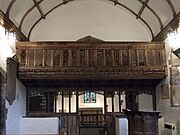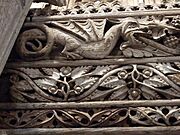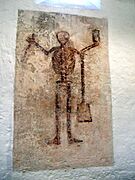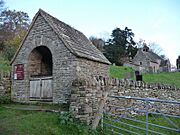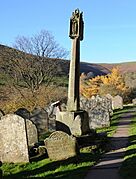St Issui's Church, Partrishow facts for kids
Quick facts for kids Church of St Issui |
|
|---|---|

St. Issui's Church, Partrishow
|
|
| Lua error in Module:Location_map at line 420: attempt to index field 'wikibase' (a nil value). | |
| OS grid reference | SO278224 |
| Location | Partrishow, Powys |
| Country | Wales |
| Denomination | Church in Wales |
| History | |
| Status | parish church |
| Founded | 1060 |
| Architecture | |
| Functional status | Active |
| Heritage designation | Grade I |
| Designated | 19 July 1963 |
| Architect(s) | W. D. Caröe (restoration) |
| Architectural type | Church |
| Administration | |
| Parish | The Vale of Grwyne |
| Deanery | Greater Brecon |
| Archdeaconry | Brecon |
| Diocese | Swansea and Brecon |
The Church of St Issui in Partrishow, Powys, Wales, is a very old and special church. It was first built around 1060. Most of what you see today was built in the 1300s and 1400s. The church was carefully fixed up in 1908 and 1909. It is most famous for its beautiful wooden screen, called a rood screen, which was made around 1500. This church is considered a Grade I listed building, which means it's a very important historical site.
Contents
History of St Issui's Church
The church is named after Issui, an early Welsh saint. He lived near a well at this spot. After he passed away, the well became a place where people would travel to visit, known as a pilgrimage site. The church was built in 1060 using gifts from these visitors.
A famous person named Gerald of Wales is thought to have given a speech at the church in 1188. This was during his journey around Wales. The church was lucky because it was not damaged during a big change in religion called the Reformation. Its two altars were saved by an order from King Edward VI in 1550.
Later, in the Victorian Era, many old churches were rebuilt. But St Issui's Church was mostly left alone. It was carefully restored by an architect named W. D. Caröe between 1908 and 1909. Today, it is still an active church in the area known as the Vale of Grwyne.
What the Church Looks Like
The church has a main area called a nave, a part near the altar called a chancel, and a porch. There is also a separate small chapel dedicated to the saint, located to the west. The walls are made of rough stone, and the roofs are made of slate. The whole building is in the Gothic style, which was popular in the Middle Ages.
On the right side of the porch, there is a rare stone bench. It faces a stone cross in the churchyard, which was used for preaching. The small tower that holds the two bells, called a bellcote, was replaced by Caröe with a stone one. The original was made of wood.
Inside the Church
The roof of the nave was built in the 1500s. The north side of the nave has no windows. The south wall has windows that were added during the Tudor period. The chancel has a special curved roof, called a wagon roof, which was also replaced by Caröe.
The Amazing Rood Screen
The most impressive part inside the church is the rood screen. This is a beautiful wooden screen that separates the nave from the chancel. It was made in 1500 and was carefully fixed by Caröe. It stretches all the way across the nave.
The screen has a detailed band of carvings at the top. These carvings show dragons or wyverns (which are like dragons) spitting out vines. A writer named Simon Jenkins described it as "exquisitely wrought," meaning it is very beautifully made. Some historians have even called it "the most perfect and elegant now standing in the kingdom."
Cool Wall Paintings
Besides the rood screen, the church has many interesting wall paintings. There are four main groups:
- A Royal Coat of Arms from the House of Stuart period. Experts believe it belongs to King James I.
- Two groups of Biblical texts, including the Lord's Prayer, the Ten Commandments, and the Apostles' Creed.
- A "Doom Figure" painting. This shows Death as a skeleton holding an hourglass and a spade in one hand, and a scythe in the other. This painting is from the 1600s or 1700s.
The Church of St Issui is a Grade I listed building, which means it's very important historically. Other structures nearby are also listed as Grade II, meaning they are also important. These include St Issui's Well, the churchyard cross, the old stable, and the lych gate (a covered gateway to the churchyard).
Gallery


